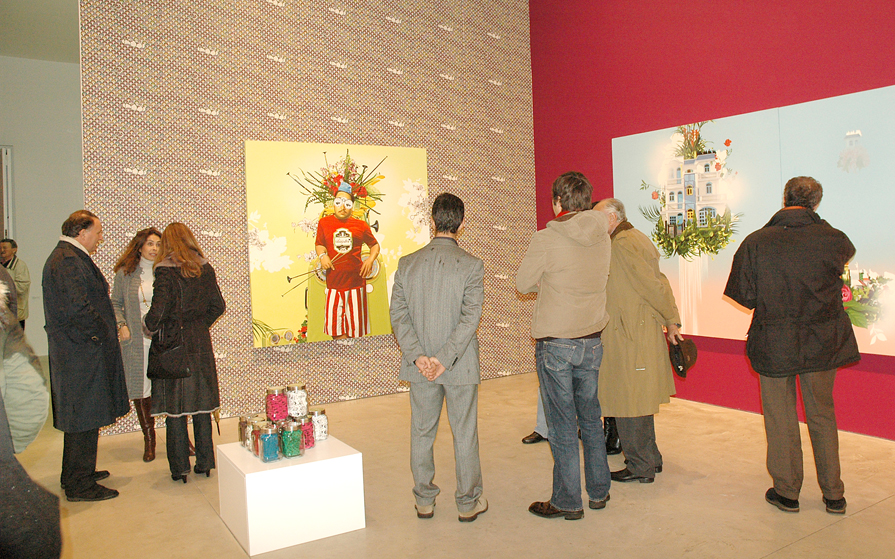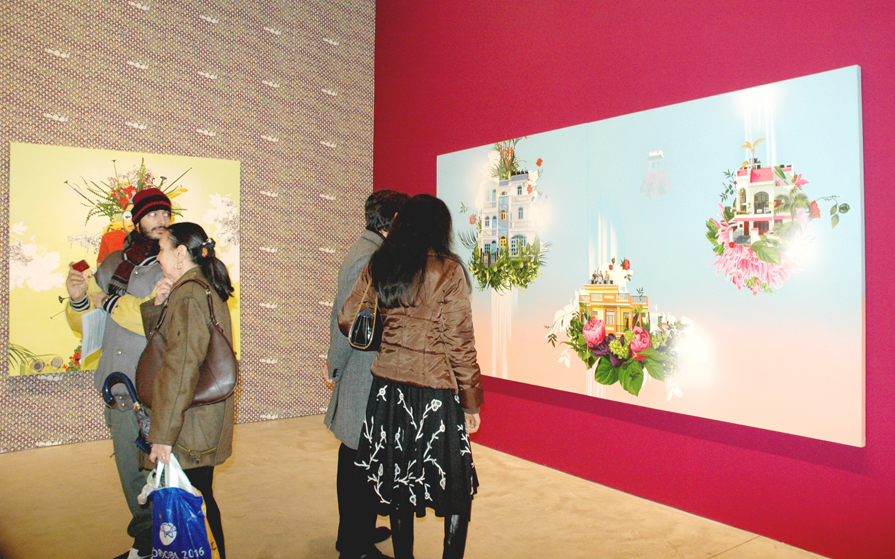Exhibitions
2024
“Arboretum at SCAD” - Savannah, Georgia, USA “Arboretum – Ebb & Flow” - Nature Morte, Mumbai2023
“Prussian Blue – Aftermath” - KNMA, Noida “Arboretum” - Nature Morte, Dhanmill, New Delhi2022
“Kochi-Muziris Biennale” - Kochi, Kerala “Pop South Asia” - Sharjah, United Arab Emirates “The Game Play – Weeping Farm + NetZero 2030” - New Delhi “Bread Winner @ 5th Biennial Contemporary Art” - Mardin, Turkey2021
“Verbal Kabaddi VII” – Waltham Forest Council - Waltham Forest Council “Conjecture” - Nature Morte, New Delhi “Farmer is a Wrestler, Lexicon of Distress” - Art at a Time Like This2020
“Kisan Mukti March” - After Hope, Asian Art Museum “Alchemist(s)” - Pearl Lam Galleries, Hong Kong “How to reappear: Through the quivering leaves of independent publishing” - MMAG Foundation for Art & Culture, Jordan
“How to Maneuver: Shape-shifting texts and other publishing tactics” - Warehouse421, Abu Dhabi “The Sundry Effect” - Bikaner House, New Delhi2019
“Bread, Circuses and I” - Nature Morte, New Delhi “Table Manners” - Palace of Independence, Astana, Kazakhstan “Lullament²” - Ludwigsburg Kunstverein, Germany “Match Fixed/ Fixed Match” - Le Tripostal, Lille, France “Double Bounce” - Pearl Lam Galleries, Singapore “Bread, Circuses & TBD” - Yorkshire Sculpture Park, United Kingdom “Farmer is a Wrestler” - Punjab Lalit Kala Akademi, Chandigarh “Lullaments” - Stir Gallery, New Delhi2018
“Collection Bureau” - IAF, New Delhi “Breaking Ground” - India Ceramics Triennale, Jawahar Kala Jendra, Jaipur “Somnium Seminibus II” - DIP Contemporary Art, Switzerland “Escape: ‘A playground of ephemerality’-Vision Exchange” - Art Gallery of Alberta, Canada “The Sculpture Park” - at Madhavendra Palace, Nahargarh Fort, Jaipur - Nature Morte2017
“Set Point_Laughing in the Vernacular” NGMA - Sakshi Gallery – Mumbai “Play, Pray” - Bikaner House, New Delhi “Bread, Circuses & You” - Art Fair, Dubai “Bread, Circuses & Wifi” - Pearl Lam Gallery, Hong Kong2016
“Walk of Life” - Level 01 - Khoj International Artists Association, Delhi
(Water) - Climate Control, The Manchester Museum, Manchester
Fed @ KCAD Galleries, Michigan “Memoir Bar” - Chatterjee & Lal, Mumbai
ABWAB - The Emotional Pavilion - Dubai Design Week, Dubai
FICA/IAF, New Delhi2015
“Walk of Life” - Of Games Residencies III - Khoj International Artists Association,
New Delhi “Games People Play” - Bhau Daji Lad Museum, Mumbai “Q : The Lighthouse” - Nature Morte, New Delhi2014
“Sparsha” - Touching the Senses, Ritual and Contemporary Indian Art”- Kunstmuseum,
Bochum2013
“Longing for Tomorrow II” - Meissen Porcelain, Residence of the German Ambassador to India, New Delhi “Q” - Famous Studios, Nature Morte, Mumbai “Windows of Opportunity” - Art Plural, Singapore2012
“Longing for Tomorrow” - Nature Morte, Berlin
“Nosturistic” - Hilger Contemporary, Vienna “Escape” - India Today Arken Museum of Modern Art, Denmark2011
“The Beautiful Game” - Thukral & Tagra Foundation - Project Booth, Art Summit,
New Delhi “Put It On, Again!” - Nature Morte, New Delhi “Escaped!… While I Was Cooking?” – Samtidigt (Concurrent) - Helsinki Art Museum, Finland
“Maximum India” - Kennedy Center, Washington DC “Indian Highway IV” - Lyon Museum of Contemporary Art, France “Paris Delhi Bombay” - Centre Georges Pompidou, Paris “Indian Highway” - Maxxi Museum, Rome “Future Pass” - Venice Biennale and Wereld Museum, Rotterdam “Science Mystery Magic” - BTAP Gallery and Tokyo Art Fair, Tokyo “Asianart: Sustain” - Nature Morte, Berlin “The Matter Within” - Yerba Buena Center for the Arts, San Francisco “German Return” - Nature Morte, Gurgaon2010
“Bosedk Project” - Richmond Art Gallery, Vancouver “Low-Tech Family Vacations” - Singapore Tyler Print Institute, Singapore “Middle Class Dreams” - Arario Gallery, Seoul “Escaped!… While I Was Cooking?” – Samdigit - Gallery 5, Kulturhuset, Stockholm “Match Fixed/Fixed Match” - Ullens Center for Contemporary Art, Beijing “Inside India” - Palazzo Saluzzo di Paesana, Turin “Urban Manners 2” - SESC Pompie, Sao Paulo “PEHNO – Put it On” - Khoj-in-Context- Public Art.Ecology, New Delhi “Khoj-in-Context” - Public Art.Ecology, New Delhi2009
“Hi! I am INDIA” - Escape for the Dream Land - Asia Pacific Triennial of Contemporary Arts 06, Queensland Art Gallery, Brisbane “Escape for the Dream Land” - Asia Pacific Triennial of Contemporary Arts 06, Queensland Art Gallery, Brisbane “Chalo! India: A New Era of Indian Art” - National Museum of Contemporary Art, Seoul; Essl Museum, Vienna “Thukral & Tagra, 315 Sector 23, Opp Bosedk Mall” - Gallery Barry Keldoulis, Sydney “Nouveau Riche” - Nature Morte, Berlin2008
“Imaginery Realities” - Max Wigram Gallery, London “Make Art Stop AIDS” - UCLA Fowler Museum, Los Angeles “Chalo! India: A New Era of Indian Art” - Mori Art Museum, Tokyo “The Audience & the Eavesdropper” - Phillips de Pury, London and New York “Somnium Genero Cafe” - Tokyo Art Fair, Tokyo “Somnium Genero 02” - Gallery Barry Keldoulis, Sydney “New Improved Bosedk” - Chatterjee and Lal, Mumbai2007
“PINK” - Galerie Mirchandani + Steinruecke, Mumbai “New Delhi New Wave” - Marella Gallery, Milan “Animamix Biennial” - The Museum of Contemporary Art, Shanghai “Everyday Bosedk” - Nature Morte, New Delhi “Put it On” - Bose Pacia, New York “Adolescere-Domus” - Art Statements, Art Basel 38, Nature2006
“Global Edit 06” - Armani Casa, Wallpaper Magazine, Milan “Vector Classics” - Alliance Francaise, New Delhi “Vector Classics” - Jehangir Nicholson Gallery, NCPA, Mumbai2005
“Art which is around and behind” - Nature Morte, New Delhi
“Iconography” - Nature Morte, New Delhi2004
“Visual Dialogue” - Hype Gallery, London



NEW DELHI NEW WAVE | 2007
On Milan’s art scene, art dealer Primo Marella is what you could call a mover and a shaker. Director of Marella galleries in Milan and Beijing, he has now opened a second Milan gallery called Primo Marella Gallery, a venue devoted to contemporary art sited just a few blocks away from his older Marella Gallery, which is situated in the nearby Via Lepontina. Both spaces are tactically located in an animated, commercial area of northeastern Milan, a multicultural milieu that perfectly matches the multicultural ambitions of the galleries themselves.
The new 500-square-meter Marella Gallery is designed by London-based Italian architect Claudio Silvestrin, a minimalist designer whose projects include the Fondazione Sandretto Re Rebaudengo in Turin and White Cube and Victoria Miro galleries in London. Airy and elegant, almost solemn, Silvestrin’s design has certainly resulted in a great place to show art. Even the empty gallery itself would be worth a visit.
As for Marella, after exploring China through a series of successful and much-praised exhibitions of contemporary Chinese art, he has now turned his attention to India. “New Delhi, New Wave,” Nov. 22, 2007-Jan. 19, 2008, highlights work by members of the new Indian avant-garde: Baba Anand, Kriti Arora, Krishnaraj Chonat, Anita Dube, Shilpa Gupta, Subodh Gupta, Bharti Kher, Sonia Khurana, N. Pushpamala, Ravinder Reddy, Tejal Shah, Barat Sikka, Bala Subramaniam and Tukral & Tagra. The show is organized by Jerome Neutres, an independent curator who heads the visual and performing arts department of the French Embassy in New York.
Though many of the works in the show are clearly rooted in the culture of India, they also challenge typical views of Indian society, and tend to suggest some kind of Indian identity crisis in the new international world.